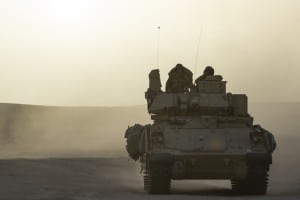The Army has restarted its Optionally Manned Fighting Vehicle (OMFV) prototype solicitation effort, releasing a market survey to industry and detailing a new focus on increasing vendor participation in the vehicle development phase.
Officials on Friday detailed the decision to reboot its search for OMFV, which was canceled just three weeks ago, telling reporters the prototype effort will be a multi-phased approach built around “digital design” with no firm timelines yet for a production decision or fielding.

“We are approaching this significantly different than we did in the first case,” Bruce Jette, the Army’s top acquisition official, told reporters. “We’ve done an analysis of the challenges and difficulties with the original approach, and we’ve come back with, I think, a much more open, flexible and innovative approach.”
The Army announced in mid-January it would cancel the current acquisition effort for OMFV, its program to replace Bradley fighting vehicles, which faced scrutiny after a single bid sample from General Dynamics [GD] was accepted for the program’s prototype phase (Defense Daily, Jan. 16).
The new effort will include collecting industry’s thoughts from the market survey before releasing a request for white papers, and then ultimately selecting five vendors to deliver a “rough digital prototype” of their offerings.
“[Since] it’s a digital prototype, we’ll end up not bending metal until later in the program. It gives a great deal of more flexibility for us to explore possibilities and for industry to offer greater possibilities. It also gives us a chance to take a look at these things in a much more integrated fashion,” Jette said.
The Army will then downselect from five to three prime contractors to move into a “detailed digital design” period that will ultimately lead to a critical design review for OMFV requirements.
“This will be where we proof out that all the technologies that are being offered can be accomplished, that they can be fitted together, that we have open architectures, that there’s flexibility in the designs,” Jette said.
Gen. Mike Murray, head of Futures Command, told reporters the new search will work off a two-page “characteristics document” that states the Army’s broad problem set for OMFV rather than delivering a list of prescriptive requirements to industry.
The document, which is still being finalized, includes nine broad points rather than including specific points such as “two vehicles per C-17” or calling for a certain weight, according to Murray.
The following phase will then select two vendors to build the physical prototypes intended to verify what the Army has gleaned from the digital and modeling simulations, as well as an increased number of soldier touchpoints.
From the two prototypes, the Army will eventually select a single vendor and finalize the OMFV characteristics for an initial requirements document.
Murray said timelines for each phase will come together during these early discussions with industry, with Jette adding that senior leadership is open to adjusting the fielding date, which has been previously been targeted for 2026.
“We don’t know the timing yet. And even though we don’t know the timing yet, timing is important. We’re going to inform the delivery date based upon these early conversations with industry and then we’ll look at the operational environment about when we need to deliver,” Murray said.
Jette said industry has been receptive to the new approach, specifically regarding to the move away from the “expenditure and rigidity of building a physical prototype” upfront.
“We’ve called industry leaders, as well, to see how they received the approach, and they all thought this was a great way to move forward,” Jette said. “In talking to potential OEMs (Original Equipment Manufacturers), all of them have expressed significant interest in participating and a belief that is a much more open approach that allows them to essentially offer much better solutions.”